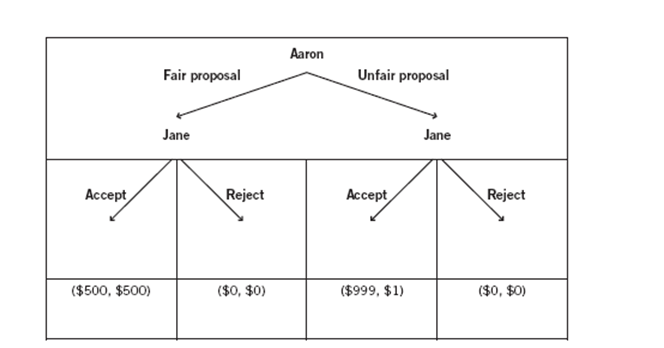The decision tree depicts two players (Jane and Aaron) playing an ultimatum game where Aaron is given $1,000 and asked to propose a way of splitting it with Jane. When Jane learns Aaron’s proposal, Jane chooses whether to accept or reject the split. If Jane accepts the split, both players receive the money according to Aaron’s split proposal. If Jane rejects the split, both players receive nothing. This game will be played only once, so Aaron does not have to worry about reciprocity when making his choice.
There are four sets of payoffs at the terminal nodes of the decision tree. In each node, the dollar amount to the left of the comma represents Aaron’s payoff, and the dollar amount to the right of the comma represents Jane’s payoff.
-If Aaron could be 100% certain that Jane was rational, did not care about fairness, and always made decisions to maximize her payoff regardless of the situation she might find herself in, Aaron would likely offer a(n) :
A) unfair proposal and ultimately receive a payoff of $500.
B) unfair proposal and ultimately receive a payoff of $999.
C) unfair proposal and ultimately receive a payoff of $0.
D) fair proposal and ultimately receive a payoff of $500.
E) fair proposal and ultimately receive a payoff of $0.
Correct Answer:
Verified
Q41: Consider the accompanying decision tree and information
Q42: Consider the following scenario to answer the
Q44: Peggy and Marcy are playing an ultimatum
Q67: Economists generally assume that people make:
A) predictable,
Q74: The _ game is a common game
Q82: Consider the following scenario when answering the
Q86: People who are risk averse
A) prefer a
Q92: Consider the following decision tree and information
Q98: The decision tree depicts two players (Jane
Q100: Proponents of fairness would likely believe that
A)
Unlock this Answer For Free Now!
View this answer and more for free by performing one of the following actions

Scan the QR code to install the App and get 2 free unlocks

Unlock quizzes for free by uploading documents